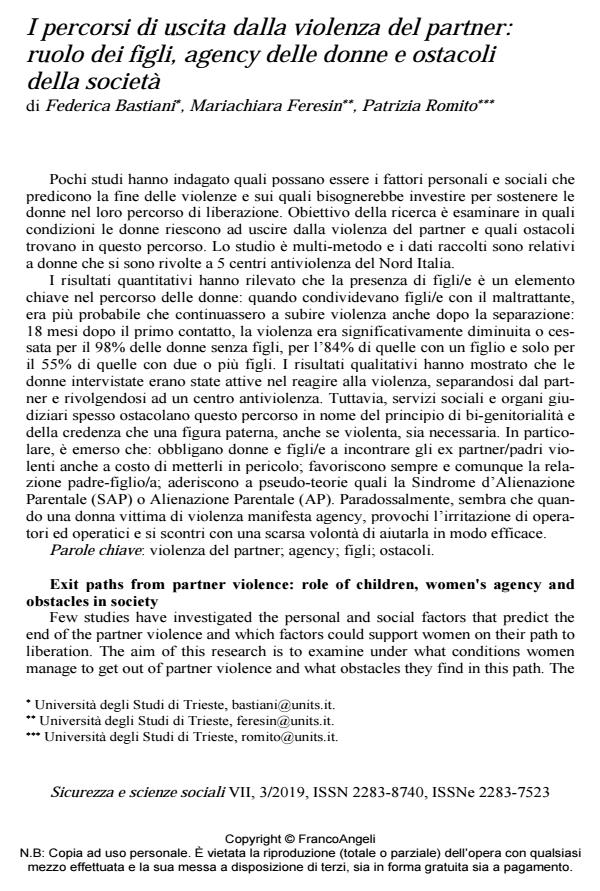Exit paths from partner violence: role of children, women's agency and ob-stacles in society
Journal title SICUREZZA E SCIENZE SOCIALI
Author/s Federica Bastiani, Mariachiara Feresin, Patrizia Romito
Publishing Year 2020 Issue 2019/3
Language Italian Pages 20 P. 65-84 File size 206 KB
DOI 10.3280/SISS2019-003006
DOI is like a bar code for intellectual property: to have more infomation
click here
Below, you can see the article first page
If you want to buy this article in PDF format, you can do it, following the instructions to buy download credits

FrancoAngeli is member of Publishers International Linking Association, Inc (PILA), a not-for-profit association which run the CrossRef service enabling links to and from online scholarly content.
Few studies have investigated the personal and social factors that predict the end of the partner violence and which factors could support women on their path to liberation. The aim of this research is to examine under what conditions women manage to get out of partner violence and what obstacles they find in this path. The study is multi-method and the data collected are related to women who turned to 5 anti-violence centers in Northern Italy. The quantitative results revealed that the presence of children is a key element in the path of women: when they shared children with the abuser, they were more likely to continue to suffer violence even after separation: 18 months after the first contact, violence had significantly decreased or ceased for 98% of childless wom-en, 84% of those with one child and only 55% of those with two or more children. The qualitative results showed that the women interviewed had been active in re-acting to violence, separating from the partner and going to an anti-violence cen-ter. However, social and legal services often hinder this path in the name of the principle of bi-parenthood and the belief that a father figure, even if violent, is necessary. In particular, it emerged that: they oblige women and children to meet violent ex-partners / fathers even at the cost of endangering them; they always fa-vor the father/child relationship; they adhere to pseudo-theories such as Parental Alienation Syndrome (PAS) or Parental Alienation (PA). Paradoxically, it seems that when a woman victim of violence manifests agency, it causes the irritation of operators and operatives and clashes with a lack of willingness to help her effec-tively.
Keywords: Partner violence; agency; children; obstacles.
Federica Bastiani, Mariachiara Feresin, Patrizia Romito, I percorsi di uscita dalla violenza del partner: ruolo dei figli, agency delle donne e ostacoli della società in "SICUREZZA E SCIENZE SOCIALI" 3/2019, pp 65-84, DOI: 10.3280/SISS2019-003006